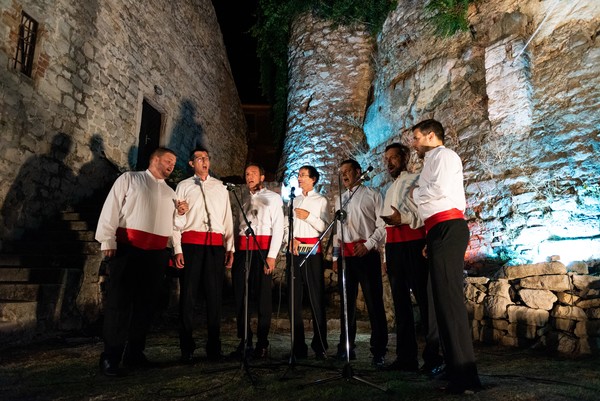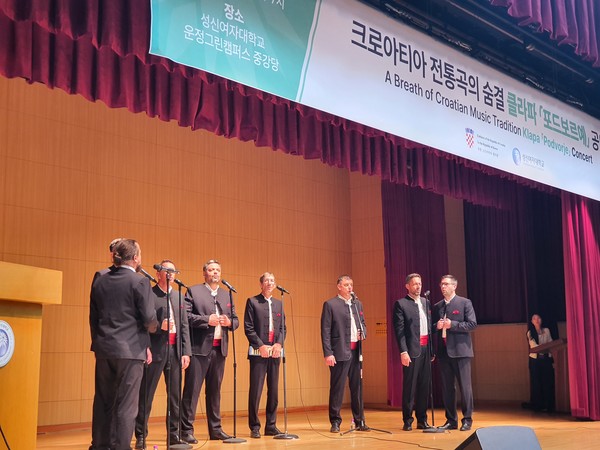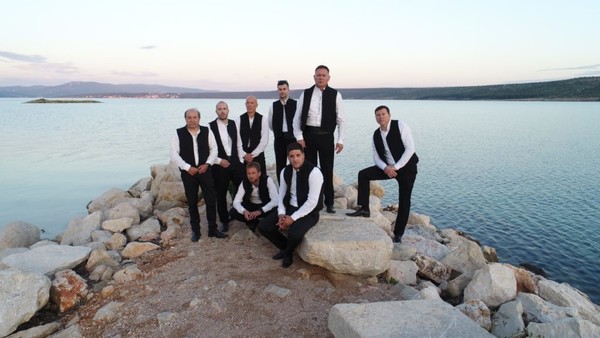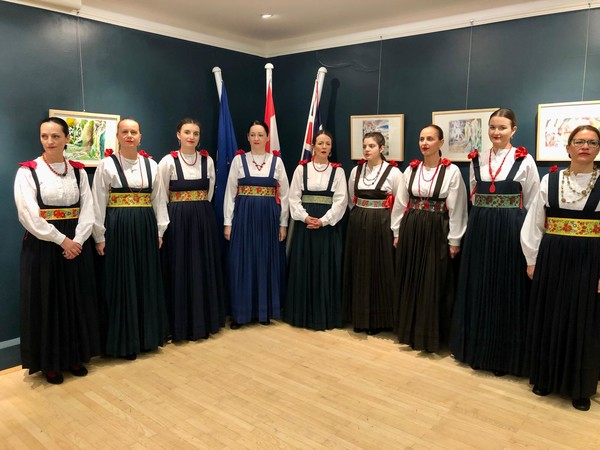Klapa Singing Tradition in Croatia

[아츠앤컬쳐] 크로아티아는 풍부한 문화 유산으로 잘 알려져 있다. 그 중 하나는 2012년 유네스코 인류무형문화유산으로 등재된 '클라파' 가창(歌唱)이다. 진정한 클라파는 반주 없이 아카펠라로 연주된다. 이 노래는 수세기 동안 크로아티아의 달마티아 지역에서 발전한 전통 민속 음악에 뿌리를 둔다. '클라파'라는 단어는 '친구들'을 의미하며, 주로 바다, 사랑, 와인, 고향을 주제로 바닷가 교회 음악에서 기원했다. 이제는 사라진 과거의 삶을 회상할 때조차도 경외심을 담아 이전 세대의 훌륭한 가치를 찬양하곤 한다.
클라파는 여러 파트로 이루어진 아카펠라 곡으로, 멜로디 라인의 흐름, 화음의 구성, 가사의 내용 등 그들만의 음악적 구조를 통해 그 독특한 특징을 드러낸다. 전통적으로 클라파는 지휘자나 악보 없이 귀로 듣고 연주된다. 가장 높은 음역의 목소리가 노래를 이끌며, 다른 가수들이 화음을 맞춰 부른다. 클라파 그룹은 단순히 가창력이 아니라, 친밀하고 조화로운 성격으로 뭉친 친구들로 형성되었기 때문에 '가장 높은 음역'이 중요하다. 일반적으로 클라파 그룹은 5~8명의 가수로 구성되며, 전통적인 남성 클라파는 제1 테너, 제2 테너, 바리톤, 제1 베이스, 제2 베이스로 구성된다. 시간이 지나면서 여성 및 혼성 클라파 그룹도 생겨났다.
클라파 노래는 작은 항구와 섬에서 시작되었으며, 젊은이들이 친구들과 함께 악기 없이 노래하곤 했다. 여름이 되면 크로아티아의 선술집, 광장, 해변, 심지어 해안과 섬을 따라 배 위에서 관광객들이 크로아티아 호스트들과 함께 아카펠라 클라파를 즐기는 광경을 자주 볼 수 있다.
클라파는 국경을 초월한다. 가사를 이해할 필요 없이, 마치 바다의 파도처럼 흐르는 멜로디에 몸을 맡기기만 해도 충분하다. 관광객들은 호스트들과 함께 와인 한 잔을 즐기고 해산물 요리를 맛보며, 음악에 흠뻑 빠질 수 있다. 클라파 가수들은 클라파 노래 전통과 그로 인해 형성되는 동료애와 삶의 방식을 열렬히 사랑한다. 그들은 다양한 배경과 직업을 가지고 있지만, 시대를 초월한 음악 유산에 대한 사랑으로 하나로 뭉쳐 있다.

여름 동안 관광객들은 1967년부터 개최된 달마티안 클라파 페스티벌이 열리는 오미스에서 클라파 공연을 즐길 수 있다. 현재 크로아티아에는 800개 이상의 클라파 그룹이 있으며, 해외에서도 점점 더 인기를 얻고 있다.
최근 카슈텔 슈츄라츠 지역의 클라파 포드보르예그룹은 클라파를 소개하는 서울 공연을 열었다. 이들은 성신여대에서 열린 저녁 공연과 한국 국립극장 앞 무대에서의 공연을 통해 한국 관객들에게 클라파를 선보였다. 작년에 런던에서는 여성 클라파 그룹 세사리체의 공연이 영국 관객들을 사로잡았다. 곧 코르출라 섬 출신의 유명한 클라파 그룹 쿰판니가 세계 곳곳에서 공연을 이어갈 예정이다.
클라파는 우리를 감동시키고 친구, 가족, 공동체의 중요성과 같은 진정한 삶의 가치를 상기시켜 준다. 이것들은 우리가 때때로 그리워하며 다시 돌아오기를 바라는 것들이며, 노래를 통해 이들을 기리고 찬양하면서 기쁨을 찾게 한다.
번역 박지윤 크로아티아 대사관 비서관

Klapa Singing Tradition in Croatia
The Republic of Croatia is well known for its rich cultural heritage. One of these is undoubtedly "Klapa singing," which was inscribed on UNESCO’s List of Intangible Cultural Heritage of Humanity in 2012.
Authentic klapa singing is performed a cappella, without any instrumental accompaniment. It has its roots in traditional folk music that evolved over centuries in the Dalmatian region in Croatia. The word "Klapa" means "a group of friends" and has its origins in coastal church singing, typically center on themes of the sea, love, wine, and homeland. Even when reflecting on a past way of life that has faded away, the songs are imbued with a sense of reverence, often celebrating the admirable values of earlier generations.
Klapa songs are homophonic a cappella compositions featuring multipart singing, recognizable by their internal musical structure—movement of melodic lines, harmonic construction, and lyrical content. Traditionally, klapa singing is performed by ear, without the use of a conductor or sheet music. The highest voice leads the song, with the other singers joining in harmony. It's important to note the significance of the "highest voice," as klapa groups were formed by friends united by their close bond and harmonious personalities, rather than just vocal ability.
A typical klapa group consists of 5 to 8 singers, reflecting the close bond among friends. In a traditional male klapa, the voices include a first tenor, second tenor, baritone, first bass, and second bass. Over time, female and mixed klapa groups have also been introduced.
Klapa singing originated in small coastal towns and islands, where young men would gather in groups to sing with friends, typically without instruments. In the summer, it’s common to see tourists in Croatia joining in on a cappella klapa singing with their Croatian hosts in taverns, on town squares, beaches, and even boats along the coast and islands. Klapa singing knows no boundaries; understanding the words isn’t necessary—just letting the melody, which flows like the waves of the sea, carry you is enough. Tourists can enjoy a glass of wine and savor seafood delicacies with their hosts, all while immersed in the music.
Klapa singers are ardent devotees, deeply passionate about the klapa singing tradition and the sense of camaraderie and lifestyle it fosters. They come from diverse backgrounds and professions, united by their love for this timeless musical heritage.
During the summer, tourists can also enjoy the Dalmatian Klapa Festival in Omiš, which has been held since 1967. Today, there are over 800 klapa groups in Croatia, and they are becoming increasingly popular abroad. Recently, Klapa Podvorje from Kaštel Sućurac held concerts in Seoul. They introduced the Korean audience to klapa singing with an evening concert at Sungshin University and an earlier performance on the concert stage in front of the Korean National Theater.

Last year, British audiences were captivated by the performance of the women’s klapa group Cesarice in London. Soon, the renowned klapa group Kumpanji from the island of Korčula is set to follow with their own performance, along with many others around the world.
Klapa singing transports us and reminds us of the true life values—the importance of friends, family, and community. These are the things we sometimes remember with nostalgia, longing for their return, and ultimately finding joy in celebrating them through song.

글 Loreta Bertosa-Kusen
Minister Plenipotentiary
Embassy of Croatia, London

